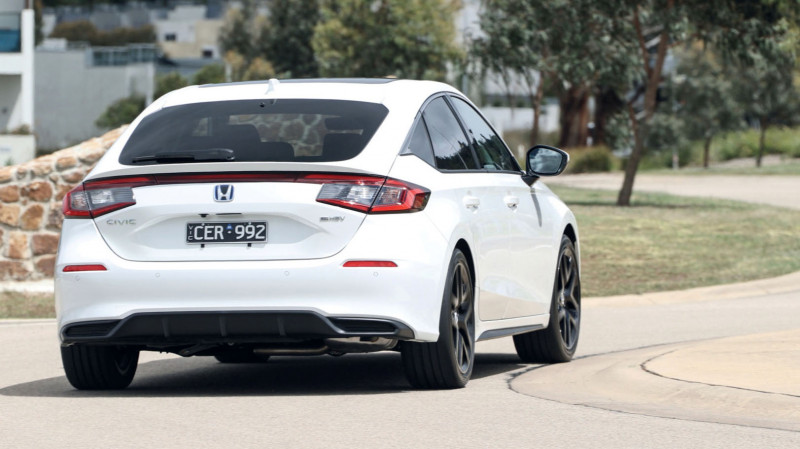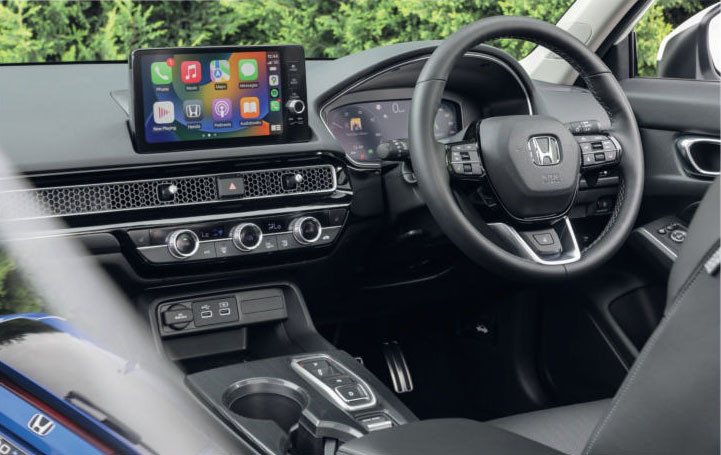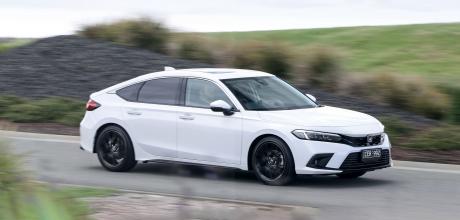2024 Honda Civic e:HEV LX Hybrid
Quiet achiever attempts to justify the $55K asking price
HOW MUCH FOR HONDA’S NEW CIVIC HYBRID?
There are some cars where the USP leaps straight out at you. The Honda Civic e:HEV LX is not one of them. But where more overt vehicles can result in that initial novelty dulling fairly quickly, a grower like this hybrid Civic rewards those who are in it for the longer haul.

Of course, Honda is no newbie when it comes to selling hybrids in Australia. It was first to market here back in 2001 with the original Insight and it was even brought us a hybrid supercar, the 2017 NSX NA2. In between, it sold hybrid versions of the Civic, with the Integrated Motor Assist tech from 2003, before evolving in 2006 to an electrical system 50 percent more powerful that could run the car in pure EV mode under light demand.
Twenty years of hybrid experience in the Civic has taught Honda a great deal about what customers actually want and that answer appears to be invisibility. They want the benefits of hybrid drive such as cleanliness, torque fill and quietness without advertising the fact. In short, they want the mainstreaming of hybrid tech.

That’s exactly what this 11th generation Civic delivers. It’s not immediately apparent that it’s a hybrid at all. The subtle blue ring around the Honda logo on bonnet and boot will be lost on most observers. Likewise the hidden single tailpipe and the brake discs that are an inch bigger in diameter will only be apparent to the most ardent marque tragics.
The $55K drive-away price is about seven grand more than the standard non-hybrid Civic VTi LX. But where that car is powered by a 1.5-litre engine good for 131kW and 240Nm, the hybrid gets a more relaxed 2.0-litre unit that generates 135kW and 315Nm. And it has a few tricks up its sleeve beyond the headline stats.

Jump inside and despite the two cars both wearing LX badges, the hybrid just gets more kit. It’s subtle stuff, but cast your eye around the cabin and you’ll notice a panoramic glass sunroof, heated steering wheel, two rear USB slots versus the petrol car’s one, eight-way power adjustment for the front seats, black leather-appointed seats, extra coat hooks, white contrast stitching and mood lighting and a smart keycard.
Possibly the most intriguing feature is buried in the guts of the e:HEV’s wiring. The Telematics Control Unit doesn’t sound immediately thrilling, but this box of gadgetry integrates the Honda Connect platform.
This allows Civic e:HEV owners to download an app to their phones which allows all kinds of Tesla-style remote functionality. Aside from the usual functionality like remote starting the vehicle, climate preconditioning and headlight flashing to show where your car is in an airport car park, Honda Connect is capable of a bunch of really advanced features.
Let’s say you’re lending the car to your kids when you’re on holiday. You can geofence an area and the app will let you know if the car strays outside it. Or if it exceeds a selected speed for a selected amount of time. You can track the car if it’s been stolen. If it’s been involved in an accident, it can automatically let the emergency services know how many people were in the car, and the severity/type of the incident.
The car can send a log file to your local Honda service centre if a warning light appears on the dash, so they’ll know what’s happening with the car before it even arrives with them, potentially saving you time and money.
If you’re heading out on a journey, you can check the vehicle’s fuel level before you go and budget time for a trip to the servo accordingly. Left the dome light on when you were in the car? It’ll even alert you if the battery level is dropping to save you the hassle of a flat battery in the morning. There’s a stack of other functionality like trip logging, driver behaviour reporting and so on. The best part is that Honda offers a complimentary five-year subscription to the service. In other words, it’s good for as long as your warranty and roadside assist packages.
Elsewhere, the Japanese-built Civic e:HEV LX gets a 10.2-inch driver information display to back up the 9.0- inch centre screen. The Apple Carplay installation is wireless but the Android Auto installation requires some sort of umbilical connection. The screen is slick and relatively easy to use and marshals a punchy 12-speaker Bose audio system.
Just three paint colours are offered. Platinum White pearlescent is standard and there are two premium paint finishes: Crystal Red metallic and Crystal Blue metallic.
How do rivals compare on value? Before we answer that question, we have to get settled on quite what we’re dealing with here.
Mentally position the car as a Honda Civic and all of your mental heuristics are cueing you into a smallish hatch that sits near the top of its mainstream bracket. Then you’re told that it’s $55K driveaway and you start talking about how cheap compact hatches were back in the day before segueing effortlessly into how policemen now look so young and how wonderful trains used to be.
Thing is, the Civic isn’t that sort of car anymore. Its footprint on the road is bigger than an E39 BMW 5 Series. And the finish inside is probably as good as the opening models in BMW, Audi or Mercedes-Benz’s range. And you can bet that the complexity of this car, the sheer amount of intellectual property hardwired into it, trumps any of those brands’ entry-level offerings.
Moving round to the back, the higher floor houses the battery pack, so whereas the petrol Civic VTi LX features a 404-litre boot with 45 litres under the floor, the e:HEV LX makes do with 404 litres and a mere five litres underfloor. That’s still hardly catastrophic given that a Golf delivers 374L of space and a Corolla hybrid a mere 333L. I’m not going to totally spoil the surprise here, but wait until you get to play with the clever parcel shelf and you’ll wonder why nobody else hasn’t hit upon Honda’s novel solution earlier.
The hybrid drive system is pleasantly fire-and-forget. There are drive modes, which cycle through Eco, Normal, Sport and Individual, but no dedicated EV-only mode. The 2.0-litre petrol engine spends much of its time powering the generator, but drives the wheels directly at freeway speeds, largely because that’s the most efficient method. That’s key. The Civic e:HEV ruthlessly focuses on efficiency, eschewing Toyota’s complex planetary gearbox in favour of a fixed-gear electronically controlled CVT; yes those three magic letters that make most drivers’ hearts sink to their boots. While this one is a better example of its ilk, there are still a few occasions when you’re pressing on that the powertrain starts mooing like a Wookiee being euthanised but for the most part it’s a cultured, refined and pragmatic set-up.
The 2.0-litre direct-injection Atkinson cycle engine is an inoffensive unit and partners with the lithium-ion battery seamlessly. Against the clock, it nets a 0-100km/h time of 8.1 seconds, making it a good deal brisker than the 1.5-litre petrol. A set of wheel-mounted paddles sit unobtrusively like little plastic ears. Instead of being used to change gear, they’re pressed into duty to adjust the amount of re-gen in order to replenish the battery. Really get after the Civic down a challenging country road and you’ll discover a fundamentally excellent chassis balance. Body control in both pitch and roll is better than you’d expect, although there is a little bit of vertical heave. The ride quality is just on the comfortable side of busy and only bigger ruts upset its composure.
The steering’s not the most communicative, but it is well weighted and accurate. Honda has worked at improving overall refinement in the cabin, but there’s still a bit of bump and thump that enters the passenger cell from the rear suspension.
Honda had wheeled out a Mk1 Insight for the launch of the Civic e:HEV and it was illuminating that this two-seat exotic lightweight was a mere litre per 100km more economical than the Civic which, when parked next to the sylph-like 860kg Insight, looked like a behemoth. The combined economy figure is quoted at 4.2 litres per 100km which feels about right based on our usage on mixed roads.
The petrol-engined VTi LX, by way of comparison, sups 6.3L/100km, which means that over a typical 15,000km year, the hybrid owner will consume 630 litres of fuel, whereby the petrol model will drink 945 litres. Extend that over a five-year ownership period and, for the sake of argument, pitch petrol prices at $2 per litre and the hybrid nets a $3150 saving in fuel alone. You then need to figure out whether the additional power, equipment and utility of Honda Connect functionality is then worth the residual $4K premium over the base car. For my money, it probably is. The fuel tank is a compact 40 litres, but given the economy of the e:HEV, it still offers very respectable touring range on a fill.
The hybrid also includes safety kit not fitted to the VTi LX VTi including a centre front airbag, rear airbags that pop up from the outboard seat cushion bolsters, traffic sign recognition, an intelligent speed limiter and an acoustic vehicle alerting system. The family hatch market is currently on its knees with rivals falling with depressing regularity. This 11thgeneration Civic is a gem, but we’d love to see a twelfth.
That’ll only happen if buyers recognise a product that works and works well without requiring a megaphone to advertise its qualities. The Honda Civic e:HEV is that car. Question is, does subtlety still have a place in today’s market?
The Civic’s footprint on the road is bigger than an E39 BMW 5 Series
PLUS Unobtrusively integrated tech; economy for a big car; impression of quality; clever Honda Connect
MINUS Engine not the most charismatic; CVT functional but not engaging; no pure electric driving mode
TECHNICAL DATA
- Model 2024 Honda Civic e:HEV LX Hybrid
- Engine 1993cc 4cyl, dohc, 16v, dual-motor hybrid
- Max power 135kW @ 5000-6000rpm
- Max torque 315Nm @ 0-2000rpm
- Transmission e-CVT
- Weight 1497kg
- 0-100km/h 8.1 sec (claimed)
- Economy 4.2L/100km
- Price $55,000 (drive away)
- On sale Now


